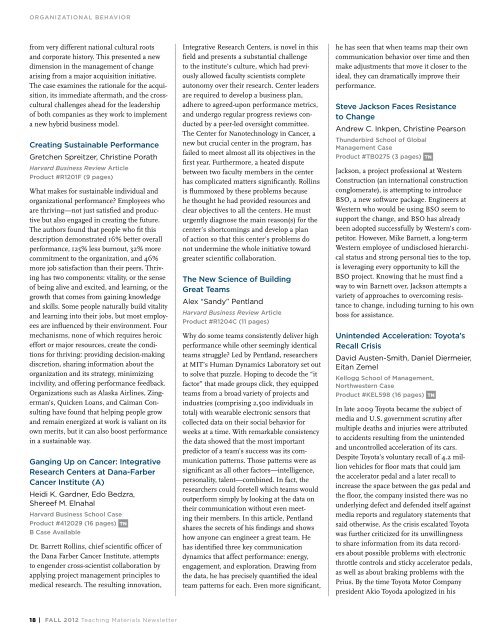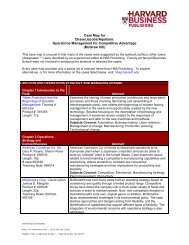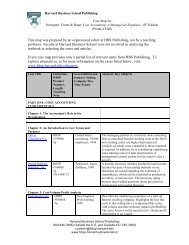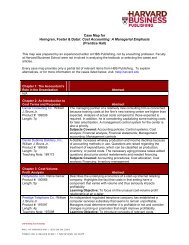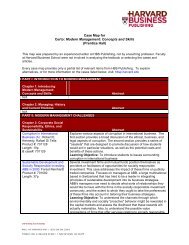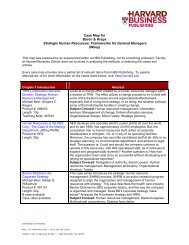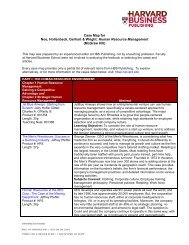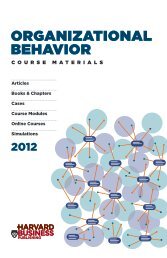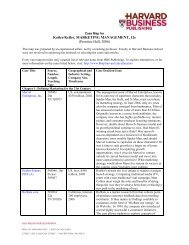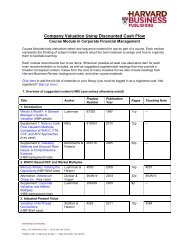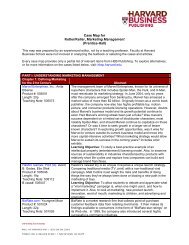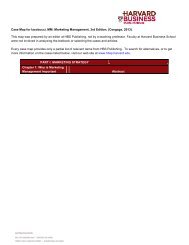teAcHing MATErIAlS - Harvard Business School Press
teAcHing MATErIAlS - Harvard Business School Press
teAcHing MATErIAlS - Harvard Business School Press
You also want an ePaper? Increase the reach of your titles
YUMPU automatically turns print PDFs into web optimized ePapers that Google loves.
ORGANIZATIONAL BEHAVIOR<br />
from very different national cultural roots<br />
and corporate history. This presented a new<br />
dimension in the management of change<br />
arising from a major acquisition initiative.<br />
The case examines the rationale for the acquisition,<br />
its immediate aftermath, and the crosscultural<br />
challenges ahead for the leadership<br />
of both companies as they work to implement<br />
a new hybrid business model.<br />
Creating Sustainable Performance<br />
Gretchen Spreitzer, Christine Porath<br />
<strong>Harvard</strong> <strong>Business</strong> Review Article<br />
Product #R1201F (9 pages)<br />
What makes for sustainable individual and<br />
organizational performance? Employees who<br />
are thriving—not just satisfied and productive<br />
but also engaged in creating the future.<br />
The authors found that people who fit this<br />
description demonstrated 16% better overall<br />
performance, 125% less burnout, 32% more<br />
commitment to the organization, and 46%<br />
more job satisfaction than their peers. Thriving<br />
has two components: vitality, or the sense<br />
of being alive and excited, and learning, or the<br />
growth that comes from gaining knowledge<br />
and skills. Some people naturally build vitality<br />
and learning into their jobs, but most employees<br />
are influenced by their environment. Four<br />
mechanisms, none of which requires heroic<br />
effort or major resources, create the conditions<br />
for thriving: providing decision-making<br />
discretion, sharing information about the<br />
organization and its strategy, minimizing<br />
incivility, and offering performance feedback.<br />
Organizations such as Alaska Airlines, Zingerman’s,<br />
Quicken Loans, and Caiman Consulting<br />
have found that helping people grow<br />
and remain energized at work is valiant on its<br />
own merits, but it can also boost performance<br />
in a sustainable way.<br />
Ganging Up on Cancer: Integrative<br />
Research Centers at Dana-Farber<br />
Cancer Institute (A)<br />
heidi K. Gardner, Edo Bedzra,<br />
Shereef M. Elnahal<br />
<strong>Harvard</strong> <strong>Business</strong> <strong>School</strong> Case<br />
Product #412029 (16 pages) tn<br />
B Case Available<br />
Dr. Barrett Rollins, chief scientific officer of<br />
the Dana Farber Cancer Institute, attempts<br />
to engender cross-scientist collaboration by<br />
applying project management principles to<br />
medical research. The resulting innovation,<br />
18 | fAll 2012 Teaching Materials Newsletter<br />
Integrative Research Centers, is novel in this<br />
field and presents a substantial challenge<br />
to the institute’s culture, which had previously<br />
allowed faculty scientists complete<br />
autonomy over their research. Center leaders<br />
are required to develop a business plan,<br />
adhere to agreed-upon performance metrics,<br />
and undergo regular progress reviews conducted<br />
by a peer-led oversight committee.<br />
The Center for Nanotechnology in Cancer, a<br />
new but crucial center in the program, has<br />
failed to meet almost all its objectives in the<br />
first year. Furthermore, a heated dispute<br />
between two faculty members in the center<br />
has complicated matters significantly. Rollins<br />
is flummoxed by these problems because<br />
he thought he had provided resources and<br />
clear objectives to all the centers. He must<br />
urgently diagnose the main reason(s) for the<br />
center’s shortcomings and develop a plan<br />
of action so that this center’s problems do<br />
not undermine the whole initiative toward<br />
greater scientific collaboration.<br />
The New Science of Building<br />
Great Teams<br />
Alex “Sandy” Pentland<br />
<strong>Harvard</strong> <strong>Business</strong> Review Article<br />
Product #R1204C (11 pages)<br />
Why do some teams consistently deliver high<br />
performance while other seemingly identical<br />
teams struggle? Led by Pentland, researchers<br />
at MIT’s Human Dynamics Laboratory set out<br />
to solve that puzzle. Hoping to decode the “it<br />
factor” that made groups click, they equipped<br />
teams from a broad variety of projects and<br />
industries (comprising 2,500 individuals in<br />
total) with wearable electronic sensors that<br />
collected data on their social behavior for<br />
weeks at a time. With remarkable consistency<br />
the data showed that the most important<br />
predictor of a team’s success was its communication<br />
patterns. Those patterns were as<br />
significant as all other factors—intelligence,<br />
personality, talent—combined. In fact, the<br />
researchers could foretell which teams would<br />
outperform simply by looking at the data on<br />
their communication without even meeting<br />
their members. In this article, Pentland<br />
shares the secrets of his findings and shows<br />
how anyone can engineer a great team. He<br />
has identified three key communication<br />
dynamics that affect performance: energy,<br />
engagement, and exploration. Drawing from<br />
the data, he has precisely quantified the ideal<br />
team patterns for each. Even more significant,<br />
he has seen that when teams map their own<br />
communication behavior over time and then<br />
make adjustments that move it closer to the<br />
ideal, they can dramatically improve their<br />
performance.<br />
Steve Jackson Faces Resistance<br />
to Change<br />
Andrew C. inkpen, Christine Pearson<br />
Thunderbird <strong>School</strong> of Global<br />
Management Case<br />
Product #TB0275 (3 pages) tn<br />
Jackson, a project professional at Western<br />
Construction (an international construction<br />
conglomerate), is attempting to introduce<br />
BSO, a new software package. Engineers at<br />
Western who would be using BSO seem to<br />
support the change, and BSO has already<br />
been adopted successfully by Western’s competitor.<br />
However, Mike Barnett, a long-term<br />
Western employee of undisclosed hierarchical<br />
status and strong personal ties to the top,<br />
is leveraging every opportunity to kill the<br />
BSO project. Knowing that he must find a<br />
way to win Barnett over, Jackson attempts a<br />
variety of approaches to overcoming resistance<br />
to change, including turning to his own<br />
boss for assistance.<br />
Unintended Acceleration: Toyota’s<br />
Recall Crisis<br />
David Austen-Smith, Daniel Diermeier,<br />
Eitan Zemel<br />
Kellogg <strong>School</strong> of Management,<br />
Northwestern Case<br />
Product #KEL598 (16 pages) tn<br />
In late 2009 Toyota became the subject of<br />
media and U.S. government scrutiny after<br />
multiple deaths and injuries were attributed<br />
to accidents resulting from the unintended<br />
and uncontrolled acceleration of its cars.<br />
Despite Toyota’s voluntary recall of 4.2 million<br />
vehicles for floor mats that could jam<br />
the accelerator pedal and a later recall to<br />
increase the space between the gas pedal and<br />
the floor, the company insisted there was no<br />
underlying defect and defended itself against<br />
media reports and regulatory statements that<br />
said otherwise. As the crisis escalated Toyota<br />
was further criticized for its unwillingness<br />
to share information from its data recorders<br />
about possible problems with electronic<br />
throttle controls and sticky accelerator pedals,<br />
as well as about braking problems with the<br />
Prius. By the time Toyota Motor Company<br />
president Akio Toyoda apologized in his


